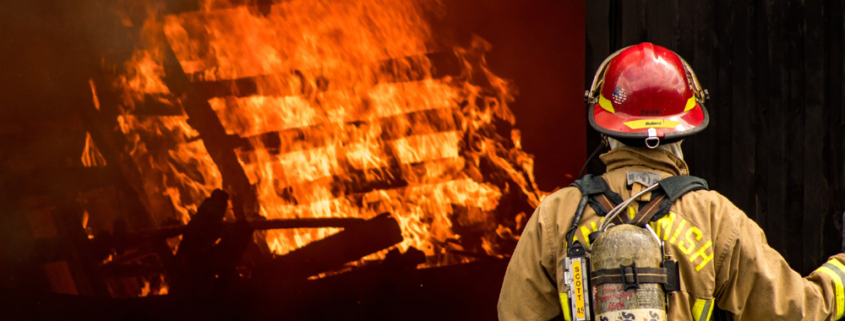House Fire Safety: Responding to House Fires
Responding to or experiencing a house fire can be devastating or life-threatening, but with the right knowledge and precautions, you can reduce the risk of a fire occurring in your home. Of course, accidents happen, often completely out of our control, so the best we can offer is our best in preparedness with house fire safety!

Prevention: Safeguarding Your Home
Install Smoke Detectors: Smoke detectors are your first line of defense. Place them on each floor of your home and in or near every sleeping area. Test them on schedule, and if they are battery operated (vs hardwired), change the batteries at least once a year. Replace the entire unit every ten years or as instructed by the manufacturer.
Safe Wiring Practices: Ensure your electrical wiring is up to code, and avoid overloading circuits or using frayed cords. Faulty wiring is a common cause of electrical fires. Hire an electrician to inspect your home if you have concerns or worries.
Kitchen Safety: The kitchen is a common source of house fires. Keep flammable materials away from the stove, never leave cooking unattended, and have a fire extinguisher within easy reach. Ensure that pot handles are turned inward to prevent accidental spills.
- Grease Fires: Do not use water to extinguish a grease fire. Instead, smother the flames by covering the pan with a lid or using baking soda.
- Microwaves: Do not place metal, or non-microwave safe materials in the microwave.
- Keep Flammable Items Away: Keep kitchen towels, oven mitts, paper towels, and any other flammable materials away from the stove, oven, and other hot appliances.
- Supervise While Cooking: Never leave the kitchen unattended when you’re cooking. If you have to leave, turn off the stove or oven. Most kitchen fires start when cooking is left unattended.
Space Heater Precautions: Maintain a 3-foot clearance around space heaters, and turn them off when leaving a room. Do not use extension cords with space heaters. Consider plugging your space heater into a smart-plug, to electronically monitor if it is in use.
Reacting to a Fire: Staying Safe
Stay Low: In a fire, smoke rises, so stay close to the ground where the air is clearer. This is especially important when moving through smoke-filled areas.
Check Closed Doors: Before opening a door, touch the door with the back of your hand. If it’s hot, do not open it. Use an alternate escape route or signal for help via phone if you have one on you, or by waving a cloth out of a window.
Create an Escape Plan: Every family should have a well-thought-out escape plan with two ways out of every room. Practice it regularly with all family members, including children. Designate a meeting point outside, a safe distance from the house.
Crawl to Safety: If you encounter smoke, stay low to the ground and crawl to the nearest exit. This minimizes smoke inhalation and toxic fumes.
Using Windows for Escape: If you can’t exit through a door, use a window to escape. If possible, lower yourself down and drop to the ground to avoid injury. Breaking the window can be a last resort if it’s your only escape route.
Responding to a Fire: Calling for Help
Dial 911: As soon as you are safely outside, call 911 to report the fire. Be prepared to provide your address and describe the situation to the operator.
Stay Out: Do not re-enter the building for any reason until firefighters declare it safe to do so. Firefighters are trained to handle these situations, and re-entry can be extremely dangerous.
Account for Everyone: Inform the fire department if anyone is missing or unaccounted for. Never go back inside to rescue someone; leave that to the professionals.

Preventive Measures: Fire Extinguishers
Choosing the Right Extinguisher: Select a fire extinguisher suitable for your home and make sure it has an ABC rating. This rating indicates that it is effective against most types of fires, including those involving ordinary combustibles, flammable liquids, and electrical equipment. See our article on fire extinguishers for specific details.
How to Use an Extinguisher: Familiarize yourself with the PASS method: Pull the pin, Aim the nozzle at the base of the fire, Squeeze the handle, and Sweep from side to side. Practice using the extinguisher before an emergency so you are prepared when needed.
Fire Drills and Preparedness: Planning Ahead
Family Fire Drills: Conduct fire drills regularly, especially if you have children. Make sure everyone knows the escape plan and meeting point. Practice escaping different rooms and scenarios to ensure everyone is prepared.
Emergency Contacts and Important Documents: Keep a list of emergency contacts, including local fire and police departments. If in doubt, 9-1-1. Also, consider storing important documents, such as passports, birth certificates, and insurance policies, in a fireproof safe.
Teaching Fire Safety: Educate family members about the dangers of fire and the importance of fire safety precautions. Teach children to stop, drop, and roll if their clothing catches fire.
Conclusion
Home fire safety is a responsibility that every household should take seriously. By implementing these preventions, reactions, and responses, you can significantly reduce the risk of fires and ensure that your family is well-prepared to handle a fire emergency. Remember that practicing fire safety can make a significant difference in protecting your loved ones and your home. Stay vigilant, stay informed, and stay safe.



